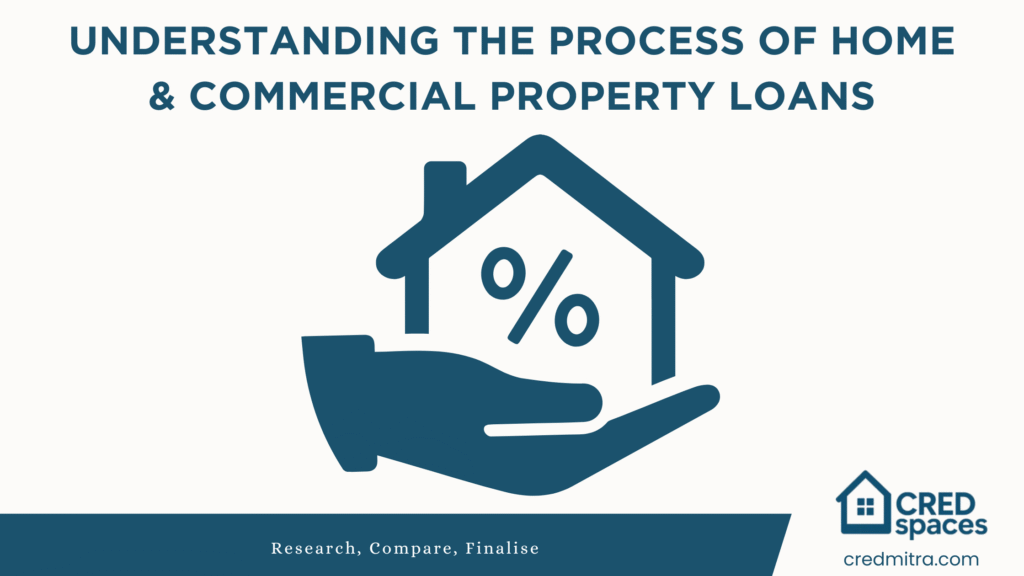
Purchasing property is among the most significant financial decisions for individuals and businesses alike. Whether you are buying your first home or investing in commercial real estate, loans play a central role in making these aspirations achievable.
Understanding the process of securing a home loan or a commercial property loan is crucial for making informed, confident decisions. This guide walks you through the end-to-end process for both, covering eligibility, documentation, timelines, and best practices.
A home loan is a secured loan provided by banks or housing finance companies (HFCs) to individuals for purchasing, constructing, or renovating residential property. The property itself serves as collateral.
– Age: Usually 21 to 60 years (salaried) or up to 65 years (self-employed)
– Income: Minimum monthly income varies by lender
– Credit Score: Preferably 700+
– Employment: Salaried individuals, self-employed professionals, or business owners
– Property Type: Must be residential and approved by the lender
Step 1 – Research and Compare Offers: Use online portals to compare interest rates, processing fees, and prepayment terms.
Step 2 – Check Eligibility and EMI: Use online calculators to check loan eligibility and estimate EMIs.
Step 3 – Application Submission: Complete the application and submit KYC documents, income proofs, employment details, and property papers.
Step 4 – Credit Appraisal: The lender reviews your credit score, income, FOIR, and may conduct a personal discussion.
Step 5 – Sanction Letter: Upon approval, a sanction letter is issued outlining the loan amount, tenure, interest rate, EMIs, and terms.
Step 6 – Property Verification & Legal Check: The lender’s valuer assesses the property, and a legal team checks title deeds.
Step 7 – Loan Agreement: You sign the agreement and submit original property documents.
Step 8 – Disbursement: The loan is disbursed directly to the builder or seller, either in full or in tranches.
– Keep 10–20% of the property cost ready for the down payment.
– Budget for registration, stamp duty, and interior costs.
– Consider balance transfers if better rates are offered later.
– Choose the tenure wisely; longer tenure reduces EMI but increases total interest paid.
These are secured loans offered for purchasing office spaces, retail outlets, warehouses, or industrial units. Typically availed by business owners, professionals, or real estate investors.
– Self-employed professionals, business owners, or salaried investors
– LLPs, private limited companies, partnerships, or trusts
– Individuals or entities with strong creditworthiness and financial records
– The commercial property must have a clear title and approved usage
Aspect | Home Loan | Commercial Property Loan |
Purpose | Residential | Office/shop/warehouse |
Interest Rate | Lower (8.5–10.5%) | Higher (9–14%) |
Tenure | Up to 30 years | Typically up to 15 years |
LTV | 75–90% | 60–75% |
Processing Time | 7–15 days | 15–25 days |
Step 1• Project Identification: Select the asset and ensure all approvals.
Step 2• Documentation: Provide business financials, KYC, bank statements, property papers.
Step 3• Loan Assessment: Lender evaluates cash flows, repayment capacity, property value.
Step 4• Loan Sanction: Receive sanction letter with finalized rates and terms.
Step 5• Disbursement: Funds disbursed in one go or in stages. For LRD, future rentals secure repayments.
– Choose between LRD, term loans, or overdraft facilities.
– Understand pre-closure and restructuring clauses.
– Ensure the property offers long-term income or business utility.
– Not comparing multiple lenders
– Over-leveraging beyond repayment ability
– Ignoring hidden charges (processing, insurance, legal fees)
– Delaying EMIs, hurting credit scores
– Buying properties with unclear legal status
Platforms like Dhano & CREDMitra simplify the loan process by:
– Providing real-time eligibility checks
– Connecting with suitable lenders
– Speeding up disbursals
– Offering dashboards to track loans
– Helping identify the right property
Whether buying your first home or expanding your business, understanding the loan process helps you plan better. With sound guidance, digital tools, and financial discipline, property ownership becomes a rewarding step towards wealth creation.
Explore smarter real estate financing at credmitra.com or app.dhano.in/apply-loan.